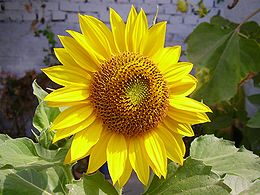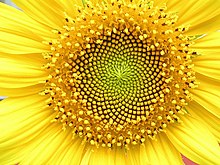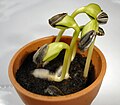Common sunflower: Difference between revisions
m Reverted edits by 209.50.183.170 (talk) to last version by Ndsqueaks |
|||
| Line 21: | Line 21: | ||
==Description== |
==Description== |
||
What is usually called the [[flower]] is actually a ''[[inflorescence|head]]'' (formally ''composite flower'') of numerous flowers (''florets'') crowded together. The outer flowers are the ''ray florets'' and can be [[yellow]], [[Maroon (color)|maroon]], [[Orange (colour)|orange]], or other [[color]]s, and are sterile. The florets inside the circular head are called ''disc florets''. The disc florets mature into what are traditionally called "[[sunflower seed]]s", but are actually the [[fruit]] (an ''[[achene]]'') of the |
What is usually called the [[flower]] is actually a ''[[inflorescence|head]]'' (formally ''composite flower'') of numerous flowers (''florets'') crowded together. The outer flowers are the ''ray florets'' and can be [[yellow]], [[Maroon (color)|maroon]], [[Orange (colour)|orange]], or other [[color]]s, and are sterile. The florets inside the circular head are called ''disc florets''. The disc florets mature into what are traditionally called "[[sunflower seed]]s", but are actually the [[fruit]] (an ''[[achene]]'') of the plant. The true seeds are encased in an inedible husk. |
||
The florets within this cluster are arranged spirally. Typically each floret is oriented toward the next by approximately the [[golden angle]], producing a pattern of interconnecting [[spiral]]s where the number of left spirals and the number of right spirals are successive [[Fibonacci number]]s. Typically, there are 34 spirals in 1 direction and 55 in the other; on a very large sunflower you may see 89 in one direction and 144 in the other. |
The florets within this cluster are arranged spirally. Typically each floret is oriented toward the next by approximately the [[golden angle]], producing a pattern of interconnecting [[spiral]]s where the number of left spirals and the number of right spirals are successive [[Fibonacci number]]s. Typically, there are 34 spirals in 1 direction and 55 in the other; on a very large sunflower you may see 89 in one direction and 144 in the other. |
||
Revision as of 14:33, 19 April 2007
| Sunflower | |
|---|---|

| |
| Scientific classification | |
| Kingdom: | |
| Class: | |
| Order: | |
| Family: | |
| Genus: | |
| Species: | H. annuus
|
| Binomial name | |
| Helianthus annuus | |
The sunflower (Helianthus annuus) is an annual plant native to the Americas in the family Asteraceae, with a large flowering head (inflorescence). The stem of the flower can grow up to 3 metres tall, with the flower head reaching 30 cm in diameter. The term "sunflower" is also used to refer to all plants of the genus Helianthus, many of which are perennial plants.
Description
What is usually called the flower is actually a head (formally composite flower) of numerous flowers (florets) crowded together. The outer flowers are the ray florets and can be yellow, maroon, orange, or other colors, and are sterile. The florets inside the circular head are called disc florets. The disc florets mature into what are traditionally called "sunflower seeds", but are actually the fruit (an achene) of the plant. The true seeds are encased in an inedible husk.
The florets within this cluster are arranged spirally. Typically each floret is oriented toward the next by approximately the golden angle, producing a pattern of interconnecting spirals where the number of left spirals and the number of right spirals are successive Fibonacci numbers. Typically, there are 34 spirals in 1 direction and 55 in the other; on a very large sunflower you may see 89 in one direction and 144 in the other.

Heliotropism
Sunflowers in the bud stage exhibit heliotropism. At sunrise, the faces of most sunflowers are turned towards the east. Over the course of the day, they move to track the sun from east to west, while at night they return to an eastward orientation. This motion is performed by motor cells in the pulvinus, a flexible segment of the stem just below the bud. As the bud stage ends, the stem stiffens and the blooming stage is reached.
Sunflowers in the blooming stage are not heliotropic anymore. The stem has frozen, typically in an eastward orientation. The stem and leaves lose their green color.
The wild sunflower typically does not turn toward the sun; its flowering heads may face many directions when mature. However, the leaves typically exhibit some heliotropism.
Cultivation and uses


Sunflowers are native to the Americas. There is some debate about where the sunflower was first domesticated. The earliest known examples of a fully domesticated sunflower were found at the Hayes site in Tennessee that date back to around 2300 B.C. There were also other remains found at the Olmec site of San Andrés dating some time before 2100 B.C.<ref>[1]ref> The Incas used the sunflower as an image of their sun god. Gold images of the flower, as well as seeds, were taken back to Europe early in the 16th century.
The Giant sunflower (Helianthus giganteus) is native to the Eastern United States. They can grow to be between 3 and 12 feet tall. They can grow from Ontario to Minnesota and Kentucky to Georgia. Their flower heads can be between 2 to 3 inches wide. They are most commonly found in valleys with wet meadows or swamps. The Giant sunflower grows between July and October.
To grow well, sunflowers need full sun. They grow best in fertile, moist, well-drained soil with a lot of mulch. In commercial planting, seeds are planted 45 cm (1.5') apart and 2.5 cm (1") deep.
Sunflower "whole seed" (fruit) is sold as snacks and can be processed into a peanut butter alternative, Sunbutter, especially in China, Russia, the United States, the Middle East and Europe. It is also sold as food for birds and can be used directly in cooking and salads.
Sunflower oil, extracted from the seeds, is used for cooking (but is less cardiohealthy than olive oil), as a carrier oil and to produce biodiesel, for which it is less expensive than the olive product.
During the 18th Century, the use of sunflower oil became very popular in Europe, particularly with members of the Russian Orthodox Church because sunflower oil was one of the few oils that was not prohibited during Lent.
The cake remaining after the seeds have been processed for oil is used as a livestock feed. Some recently developed cultivars have drooping heads. These cultivars are less attractive to gardeners growing the flowers as ornamental plants, but appeal to farmers, because they reduce bird damage and losses from some plant diseases. Sunflowers also produce latex and are the subject of experiments to improve their suitability as an alternative crop for producing hypoallergenic rubber.
For farmers not intending to grow it, the sunflower is considered a noxious weed. The wild variety will grow unwanted in corn and soybean fields which can have a negative impact on yields.
Trivia
- The sunflower is the state flower of the U.S. state of Kansas, and one of the city flowers of Kitakyushu, Japan.
- The Jerusalem artichoke (Helianthus tuberosa) is related to the sunflower. The Mexican sunflower is Tithonia rotundifolia. False sunflower refers to plants of the genus Heliopsis.
- Scientific literature reports, from 1567, that a 12 m (40'), traditional, single-head, sunflower plant was grown in Padua. The same seed lot grew almost 8 m (24') at other times and places (e.g. Madrid). Much more recent feats (past score years) of over 8 m (25') have been achieved in both Netherlands and Canada (Ontario).
- The sunflower is often used as a symbol of green ideology, much as the red rose is a symbol of socialism or social democracy.
Flower formation
-
1. The first stage of the flower formation
-
2. The flower is still covered, but faces the sun
-
3. The flower is nearly completely exposed
-
4. The flower is completely exposed
| Sunflower opening |
|---|
Gallery
-
Sunflowers in Manila, Philippines
-
Sunflowers
-
Bumble bee sampling Sunflower nectar
-
Sunflowers growing near Fargo, North Dakota
-
Lone sunflower about 2 m (6 ft, 6') tall
-
Sunflower seedlings, just three days after germination
-
Sunflower field in Eastern Bulgaria
-
Sunflower Profile
-
Sunflower and pollinator
-
Large Russian Sunflower
-
Sunflower
-
Close-up of sunflower.
-
The Netherlands, June 2006
-
A field of Sunflowers in the Canton de Genève in Switzerland
-
Fruiting head
-
Sunflower seeds in many variations and sizes.
-
Sunflower close-up.
See also
Notes
References
- Pope, Kevin; Pohl, Mary E. D.; Jones, John G.; Lentz, 3 David L.; von Nagy, Christopher; Vega, Francisco J.; Quitmyer Irvy R.; "Origin and Environmental Setting of Ancient Agriculture in the Lowlands of Mesoamerica", Science, 18 May 2001:Vol. 292. no. 5520, pp. 1370 - 1373.
- Shosteck, Robt. 1974. Flowers and Plants. An International Lexicon with Biographical Notes. Quadrangle/The New York Times Book Co. 329 pp.
- Wood, Marcia. June 2002. "Sunflower Rubber?" Agricultural Research. USDA. [2]
External links
- National Sunflower Association
- A farmer running his tractor and car with sunflower oil
- William Blake's poem, "Ah! The sunflower."
- Allen Ginsberg's poem, "Sunflower Sutra."




















